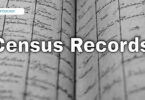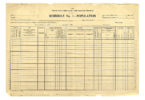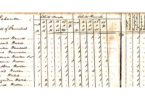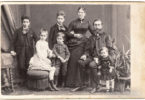The 1910 US federal census has a wealth of information in it for the intrepid genealogist. That information goes way beyond the typical name, age, and place of birth most beginning genealogists use a census to obtain. If you look at this census closely, you will find plenty of hidden genealogical gems that you might not otherwise have noticed. This is true for both beginning and experienced genealogists. Here are some of the things on the 1910 US federal census that can be of enormous benefit to you in your genealogical research.
Your Ancestor’s Address
Look closely. Your ancestor’s address was recorded in this census. This includes the name of the street as well as the house number. With this information, you can actually go and have a look at the property in person. With any luck, the house is still there and the street numbers have not been changed in the past century. If the house is not there, or a new one is in its place, you can at least get an idea of the neighborhood in which your ancestor lived, and how it might have impacted their daily lives in this time period. If you are not able to visit in person, you can use Google Maps street view to find the property online.
Race
Each census is a bit different when it comes to asking about race. The 1910 census has choices for White, Black, Chinese, Japanese, Indian (meaning Native American for this census), Mulatto (meaning biracial black and white), or Other (meaning anything else not provided as a choice on the census). If you do not know the origins of your ancestors, the Race column on this census may help point you in the right direction, or give you ideas of where to look for further information on them.
Number of Marriages
The 1910 census lets people indicate if they are married, divorced, widowed, or single. For those who are married or have been married, the number of marriages is indicated. This is helpful in looking up additional marriage records if you did not know your ancestor had more than one of them. The number of marriages is indicated by an M, followed by the appropriate number, such as M1 for a first marriage, M2 for a second one, and so on.
Number of Years Married
This census also asks the number of years of a person’s present marriage, if they are married. If you do not have the marriage date, this information will give you a close idea of what it is, and you can use that knowledge to look for the coveted marriage license or certificate.
How Many Children and How Many of Them are Living?
This is the only US census to ask both how many children had been born to a particular mother, as well as how many were living. This information can be potentially enlightening. If a mother has given birth to more children than you knew about, you have new research avenues to explore. This is also true if you did not know any of her children died before her or when they died. Looking up information on these unknown children can further fill out your family tree and give you a better idea of what your ancestor’s family and life was like between the 1900 and 1910 censuses.
Place of Birth of Parents, Immigration, and Language
This census asks for not only the place of birth of each person in the household but the places of birth of the father and mother of each person in the household. This is invaluable information when tracking the origins of ancestors whose origins are unknown. If the parents were born in a foreign country, you can also use this information to begin looking for immigration records (assuming the parents came to the United States).
If your ancestor is the immigrant or immigrated here with his or her parents, you are in luck, because this census also asks for the year of immigration and whether a person is a naturalized US citizen or not. In addition, this census asks whether a person can speak English. This is asked of each person in a household. Not only does this information provide you with a better understanding of your ancestor’s daily life in 1910, it also fills you in on what their family was like, and allows you to give a good guess as to how they eventually learned English based on their age (such as at school, at work, or from talking to other people in the neighborhood or even taking special classes).
Civil War Veteran Status
This census asks respondents if they or anyone in their house are a surviving member of the Union or Confederate Army or Navy. If you did not know an ancestor served in the Civil War, this is wonderful information. You can use it to look up their service records and to see if they have a pension record (both of which can provide valuable and sometimes detailed genealogical information, especially the pension record).
Health Information
The 1910 census was the first to ask health-related questions. In this case, respondents were asked if they or anyone in their house were blind (either totally or partially) so that they couldn’t read even with glasses, and whether anyone was deaf or mute (aka “dumb,” as was used in the 1910 terminology). Those who were deaf but not mute, or mute but not deaf were not to be recorded in the deaf and dumb column; it was only for reporting people who were both.
Education Information
If your ancestor attended school since September the prior year before this census, it will be recorded. This lets you know if your ancestor was in school, about what level they were at in school based on their age, and gives you the information you need to know where to look for any existing old school records in which they might be included.







